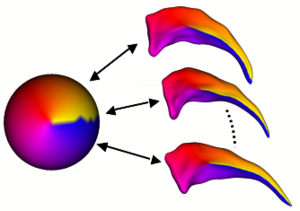Projects:PopulationBasedCorrespondence
Back to UNC Algorithms
Correspondence of complex structures using (Curvature + Location) MDL
The SPHARM-PDM based correspondence is a global correspondence method that does performs well for many structures. But in our studies it has shown to be inferior to population based correspondence methods, when assessing statistical modeling properties derived from the established correspondence, such as specificity and generalization ability of a statistical model. Current methodology in population based correspondence is based mainly on minimizing distribution properties of surface point locations and are thus not invariant to alignment.
Description
We have extended the population based correspondence framework to include curvature based measurements, such as the Koenderink Shape Index S and Curvedness C in combination with the standard location information. The implementation is based on ITK and uses the SPHARM-PDM correspondence as an initialization. We have favorably compared our combined "Curvature + Location" MDL to the standard MDL, as well as to the SPHARM approach. Especially with more complex structures, such as the femural bone and the striatal structure (composed of caudate, nucleus accumbens and putamen), our method outperforms the other methods. It also illustrates the potential of this approach of objects as complex as the human cortex, the object of study in the NAMIC year 07/08. In the followup work using an particle based entropy approach, local shape measures of curvature have proven to help improve cortical surface correspondence.
Key Investigators
- UNC Algorithms: Ipek Oguz, Martin Styner
Publications
In Print
Links
- Shape Correspondence Based on Local Curvature
- Follow up project using particle based entropy approach, jointly with NA-MIC Utah site
Project Week Results: Jun 2006
